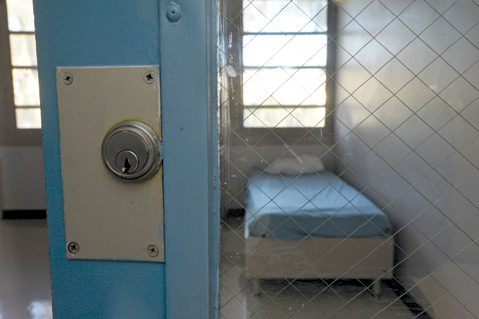Report Examines High Cost of Jailing Mentally Ill
Faith Communities Argue Practice is Inhumane and Wastes Money

A Sheriff’s report to address jail overcrowding stated in 2008 that “[County Jail] has become the County’s de facto ‘mental institution.’” Last month, a report completed by CLUE (Clergy and Laity United for Economic Justice) reiterated that statement and argued that holding mentally ill inmates in County Jail is not only inhumane but also more expensive than moving them to treatment facilities.
CLUE is a collection of faith communities that has focused its efforts in the past three years on the mentally ill population that circulates through the “revolving door” of courtrooms, emergency rooms, and jail cells. CLUE representative Maureen Earls and former public defender Nick Beeson argue that if the conservatively estimated 150 mentally ill people who are in custody for low-level offenses (charged with nondangerous, minor crimes like petty theft or drinking in public) were moved to facilities like El Carrillo Studios or the New Faulding Hotel, the county would save $2.9 million each year.
It costs $44,500 to incarcerate an inmate in County Jail each year. According to the report, that figure does not include an additional $4,000 for mental treatment and another $4,000 for medical services. Including those additional costs, the county spends $19,000 more to incarcerate mentally ill people than it would to treat people with mental-health issues in stabilizing houses, which range from Psychiatric Health Facility units to step-down facilities to stand-alone treatment centers.
In their four months of research — funded by the Santa Barbara Foundation — Earls and Beeson interviewed dozens of law enforcement personnel, mental-health treatment providers, and Housing Authority staff and found that few people agree that low-risk mentally ill individuals belong in jail.
“It’s just one of those untenable situations. We need to have options that are not jail-based,” Beeson said, explaining he hopes to bring to light previous studies — conducted by the Blue Ribbon Commission, the Grand Jury, and the County CEO between 2008 and 2011 — that demonstrated that moving those inmates out of jail would be beneficial for both tax dollars and the mentally ill population. But those studies failed to materialize into real change.
Last month, the Sheriff’s department all but secured a $38.9 million grant — in addition to $80 million set aside to build the jail — to fund an additional wing (with 228 beds) dedicated to a recidivism-reducing program in the proposed North County jail, which is expected to be operating by 2018. The county will match that grant with $3.9 million from strategic reserves. Though this additional money increases the jail’s capacity to deal with mentally ill inmates, the problem, as Beeson sees it, is “if you build it, they will come.” He’d prefer the North County jail be scaled down and that money saved from removing the 150 inmates be diverted to build facilities on county-owned property.
That’s where low-income housing expert Frank Thompson comes in. He contributed to the CLUE report and explained that the county owns hundreds of acres of land and that a proper linkage between health care, mental health, the courts, and nonprofits could halt the revolving door and improve lives. “It’s a tall order,” he admitted.
Thompson explained that AB 109 forced county jails across the state to absorb prison inmates, which is all the more reason to look for alternative solutions. He added that the annual cost for each inmate at the North County jail would likely be much greater than the annual $45,000 for each inmate at the current jail. “To do the right thing is actually cheaper,” Beeson said, adding that any cost to keep mentally ill patients out of jail would be worth it.
Getting all of the moving parts working in unison will evidently not happen overnight. The good news is that more people with mental illnesses are eligible for Medi-Cal under the Affordable Care Act. According to Public Health Director Dr. Takashi Wada, there are roughly 30,000 people in the county who have some form of mental illness and are now eligible for Medi-Cal. Further, all health insurance is now required to cover mental health and substance abuse equal to that of other medical treatment.
The CLUE report calls for an independent analysis to do a more thorough evaluation and comparison of the costs of treating low-risk people in jail as opposed to in outside facilities. Earls and Beeson will soon meet with Wada, county staff, and Sheriff’s Office personnel to discuss this further, and the issue is expected to go before the Board of Supervisors sometime in the next couple of months.



